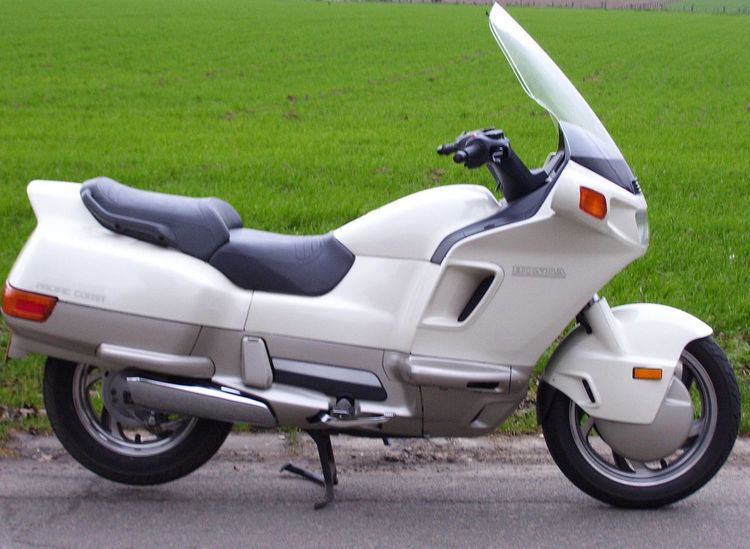Production 1989–1998 | Also called Honda Pacific Coast Class Touring | |
 | ||
Bore / stroke 79.5 mm × 80.6 mm (3.13 in × 3.17 in) | ||
The PC800 Pacific Coast is a touring motorcycle manufactured and marketed by Honda between 1989 and 1998. Named after California's Pacific Coast Highway, over 14,000 were sold in North America, Europe and Japan, with a three-year hiatus between two production runs. The bike is noted for its single integrated trunk straddling the rear wheel, full bodywork, and distinctive two-tone paint.
Contents
Like the earlier Honda Goldwing and later Rune, the Pacific Coast had been conceived and designed by Honda Research America specifically for the US market. Though subsequent Honda motorcycles would feature integral, side-opening trunks — namely the Deauville/NT700V, ST1100, Gold Wing and ST1300 — the wheel-straddling, top-opening trunk concept remained unique to the Pacific Coast.
An unorthodox motorcycle
According to a 1998 Motorcycle.org article, "when the PC debuted, it was considered a radical bike." The PC800 departed convention with its integral trunk, extensive bodywork and marketing aimed at the "white-collar professional."
Marketing
In addition to naming the PC800 after an important American highway, Honda reinforced the association between the motorcycle and other notable highways of the world; advertising copy from the 1994 Pacific Coast brochure highlighted the famed Amalfi Drive and Blue Ridge Parkway, along with, of course, the Pacific Coast Highway.
Similarly, the name of the lower body color for 1996 model referred to another important road, the Karakorum Highway, the highest international highway in the world.
In contrast to motorcycling advertising that emphasized rebellion or exaggerated masculinity, a 1989 30-second introductory television commercial for the PC800 depicted a couple awakening at a stylish waterfront home. She is seen running on the beach, he is seen showering, lifting his Rolex-like wrist watch from the bedside table, fixing coffee – all with a Honda PC800 next to a grand piano in their elegant living room, the waves crashing visibly beyond. The commercial ended with a single shot of the motorcycle at a very calm (i.e., pacific) shoreline carrying the voiceover: "Introducing the Pacific Coast, from Honda. It is the beginning of a new day."
Sales over the entire two-part production run averaged under 1,400 sales per year over ten years.
Trunk
Unlike other motorcycles that offer detachable side or top cases for storage, the PC800 has an integral waterproof trunk under the pillion (passenger seat). The passenger seat is attached to a single trunk lid that hinges upward to reveal two storage areas that straddle the rear wheel — with sufficient capacity to carry "two full-face helmets and two medium-sized gym bags", or "two grocery bags", or "four plastic bags full of groceries, along with a small bag of dog food." The trunk lid is held up by a hydraulic strut and is controlled by a release mechanism under the lockable fuel filler door.
Bodywork
Like other motorcycles with full bodywork, the PC800's plastic bodywork conceals almost the entirety of the motorcycle's mechanical underpinnings — in the manner of a scooter. While routine oil changes do not require panel removal the PC800 owners manual calls for removal and replacement of four panels (two each side) for servicing the spark plugs and seven panels for servicing the battery.
The design of the bodywork includes three vents (visible in the photo above) on each side of the bike to cool the mechanicals: a pair of forward vents on the wheel cowling, a lower vent on each side for the transmission, and two larger vents to accommodate the engine's cooling system.
In contrast to other motorcycles with full bodywork, the PC800's trunk occupies the full unbroken width of the bike's tailend while the front wheel carries a partial cowling, which reverted to an open fender in 1997-1998 model years. For the entire production run, the bodywork featured a lower-body accent color.
Features
Honda outfitted the Pacific Coast as a "low-maintenance motorcycle for daily use" aimed primarily toward first-time motorcycle owners. Riding position is standard or neutral, instrumentation is "automobile-like," switches and controls are large and clearly marked, self-canceling turn signals were included until the 1997 model year along with a seat height of 30.1 inches (760 mm) and an integrated fairing and windshield. 1989 and 1990 models offered an optional AM/FM radio.
Production data
The table below outlines production figures, factory paint colors and production notes.
The table uses serial numbers as a basis for estimating production: Official US production bikes carry serial number in the RC340 range, California models carry RC341 numbers, Japanese models carry RC341(J) numbers, and Canadian and European models carried RC342 serial numbers.
